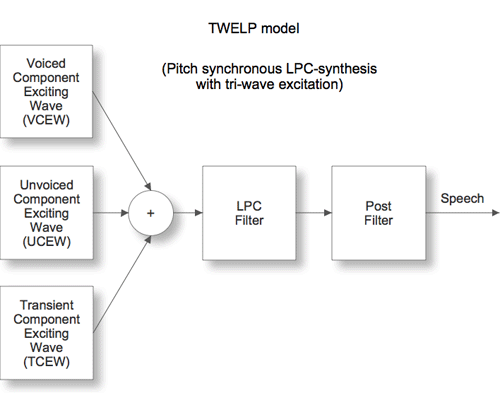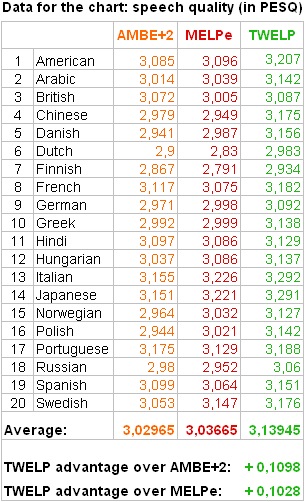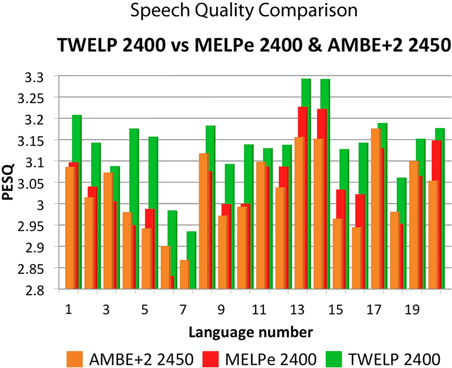DSP Innovations Inc. (DSPINI) announces new class of proprietary vocoders for wide range of bit rates from 600 bps up to 9600 bps, based on the newest speech coding technology TWELP™, for Digital Radio (HF, DMR, dPMR, etc.) and other markets.
TWELP™ technology features. The vocoder is based on newest technology of speech coding called "Tri-Wave Excited Linear Prediction"™ (TWELP) that was developed by experts of DSPINI. The technology provides the best speech quality among competitors today, thanks to:
- Advance reliable method of Pitch estimation
- Pitch synchronous analysis
- Advance tri-wave model of excitation:
- Voiced Component Excited Wave (VCEW)
- Unvoiced Component Excited Wave (UCEW)
- Transient Component Excited Wave (TCEW)
- Newest quantization schemes
- Pitch synchronous synthesis

In spite of the fact, that TWELP technology is based on well-known LPC-method, where output speech is gotten by the synthesizing LPC-filter, it is not a variety or combination of well-known speech coding methods, patented comprehensively during last 20-30 years.
TWELP is not WI-based method (PWI, LCWI, etc.), because LPC-excitation is gotten by not interpolation of the pitch-waveforms.
TWELP is not a sinusoidal/harmonic coding method, including MBE-based coding (IMBE, AMBE, MELP, etc.), because LPC-excitation is not gotten as any mixture of sinusoidal/harmonic or noisy components.
TWELP is not MPE-based or CELP-based method (MPE-CELP, ACELP, etc), because LPC-excitation is not a sequence of pulses on some positions.
TWELP is not a mixture of these methods like MELPe or HVXC because of the above mentioned.
TWELP is unique three-component representation of pitch-synchronous LPC residual that is quantized by unique speech-driven quantizers in conjunction with LPC-parameters. New technology allows to achieve much better speech quality in comparison with any known speech coding methods on the same bit rates (from 600 bps up to 9600 bps and wider).
Superiority in speech quality. Here is the comparison with AMBE+2 vocoder. TWELP 2400 bps vocoder and AMBE-3000 HDK (Rate#33: AMBE+2 2450 bps vocoder) were tested, using ITU-T P.50 speech base for 20 different languages. ITU-T P.862 utility was used for estimation of the speech quality in PESQ terms:
 我觉得这里的MOS分测试有问题,我按照他的方法测试。是分数有差异
我觉得这里的MOS分测试有问题,我按照他的方法测试。是分数有差异
A diagram demonstrates significant superiority of TWELP over AMBE+2 and MELPe in speech quality.
A few independent experts tested by listening TWELP vocoder in comparison with AMBE+2 and MELPe 2400, using method of preferences. Majority of experts preferred AMBE+2 to MELPe and significant majority of the experts preferred TWELP to AMBE+2 and MELPe, having noted much more natural human-sounding of voice in the TWELP vocoder.
Pair comparisons of the TWELP vocoders for other bit rates (TWELP 600 bps vs MELPe 600 bps, TWELP 1200 bps vs MELPe 1200 bps, TWELP 4800 bps vs GSM AMR 4750 bps, TWELP 8 kbps vs G.729 8 kbps and GSM AMR 7.95 kbps, etc.) also showed significant superiority of the TWELP over all competitors first of all in more clear natural sounding of speech. In contrast to ACELP-based vocoders (G.723.1, G.729, GSM AMR, etc.), TWELP vocoders are clear of distortions of speech, that are present in any MPE and CELP-like vocoders due to sparseness of pulses on an input of the synthesizing filter.
Superiority in quality of the non-speech signals. In contrast to other LBR vocoders (MELPe, AMBE+2, etc.), TWELP vocoders provide high quality of non-speech signals, including police, ambulance, fire sirens, etc. This feature in conjunction with high quality natural human-sounding of voice makes TWELP vocoders well suitable for replacement of analog radio by digital radio and also for other applications where high quality transmitting of non-speech signals is relevant along with high quality transmitting of speech signals.
High robustness to acoustic noise. In contrast to other LBR vocoders, TWELP vocoders are well robust to acoustic noise thanks to robust reliable method of pitch estimation and other features of TWELP technology.
High Robustness to the channel errors. "Robust" versions of the TWELP vocoders include FEC that are integrated with vocoder on base of "joint source-channel coding" approach that provides high speech quality simultaneously in noisy channel as well as in noiseless channel. FEC can operate with "soft decisions" as well as with "hard decisions" from a modem. Mode of "soft decisions" provides much better robustness in comparison with mode of "hard decisions".
Additional functionalities. The following additional functionalities are developed by DSPINI and integrated into TWELP vocoders:
- Automatic Gain Control (AGC),
- Noise Cancellation for Speech Enhancement (NCSE)
- Voice Activity Detector (VAD),
- Tone Detection/Generation (Single tones and Dual tones). The tones are transmitted through vocoder.
Technical characteristics and resource requirements:
| Bit Rate (bps) | Algorithm | Frame size (ms) | Algorithmic delay (w/o frame size) (ms) | Sampling rate (kHz) | Signal format | Bit stream format |
|---|---|---|---|---|---|---|
| 600 1200 2400 4800 9600 |
TWELP | 80 40 20 20 20 |
20 | 8 | Linear 16-bit PCM |
48 48 48 96 192 |
| Name | Functionality | Technical characteristics | |
|---|---|---|---|
| Name | Value | ||
| AGC | Automatic Gain Control | Control range: | 0 ... +20 dB |
| NCSE | Noise Canceller - Speech Enhancer |
SNR increasing | > 6 dB |
| Speech quality improvement | > 0.1 PESQ | ||
| Tone Detector |
Single/Dual tones detection | In accordance with international standards | |
| Tone Generator |
Single/Dual tones generation | Special generator, kept continuity of signal (phase and amplitude of signal of previous frame) | |
| VAD | Voice Activity Detection | Reliable detection speech in background noise | |
| CNG | Comfort Noise Generation | Type of noise | "white" |
| Level | - 60 dB | ||
* DSPINI continues optimization of the TWELP algorithm and code in order to minimize computational complexity of the vocoder.
Guarantee and support. DSPINI guarantees a quality and accordance of all technical characteristics of the product to requirement of current specifications. Testing and other method of quality control are used for guarantee support.
Any platform. Right now, TWELP vocoders for some bit rates are available just for TI's C55 DSP platform. However, DSPINI can port the vocoder software into any other DSP, RISC or general-purposes platform in short time: 2-3 months.
Microchip. TWELP 2400/3600 bps vocoder is available also as chip (IC) from CML Microcircuits.
Licensing terms. To use the vocoders, customer should obtain a license from DSPINI only.
Low price is another advantage of these vocoders. Please contact us to check it out.
Related software. TWELP vocoders may be effectively used in a bundle with other DSPINI's products:
- Linear and acoustic echo cancellers,
- Multichannel noise cancellers (including two-microphone adaptive array),
- Wired or radiomodems for any types of channels and bitrates,
- Other products.
More DSPINI's products on http://www.dspini.com
Please contact to evaluate and purchase:
| DSP INNOVATIONS INC. | |
|---|---|
| E-mail: | request@dspini.com |
| Web: | http://www.dspini.com |
| Tel/Fax: | +7 963 105 32 18 |
| Address: | 4 Slavi, Penza, 440600 |
| Russian Federation | |
Tri-Wave Excited Linear Prediction, TWELP, DSPINI and DSP Innovations logo are trademarks of DSP Innovations Inc. AMBE-3000 and AMBE+2 are trademarks of Digital Voice Systems Inc.
© 2007-2012 DSP Innovations Incorporated. All rights reserved.
